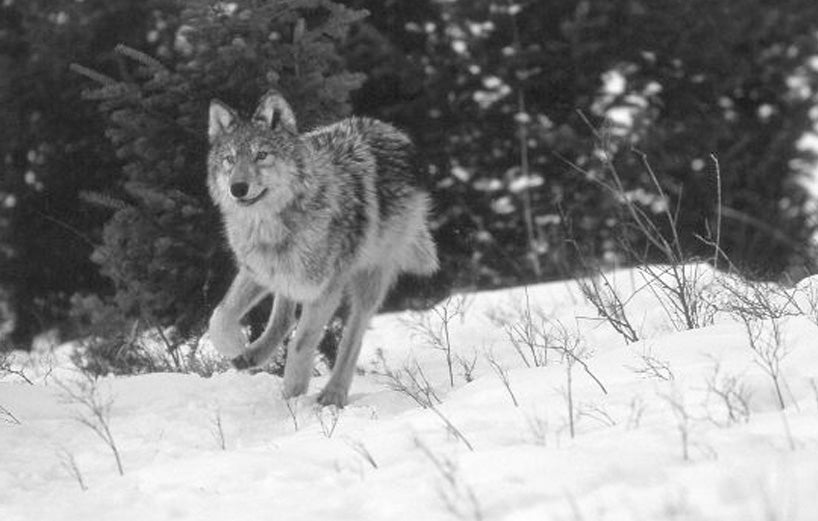Wolves in Wyoming
The gray wolf population in Wyoming is concentrated primarily in suitable habitat in the northwest portion of the state where they are legally classified as trophy game animals. Learn about wolf hunting regulations, where wolves are classified as predatory animals and trophy game animals in the state, how wolf populations are monitored and how to stay safe in wolf country.
About Wolves in Wyoming
Wolves are an intelligent and adaptive species and occupy suitable habitats in northwest Wyoming where there are large tracts of public and forested lands and lower human and livestock densities. Wolves are social carnivores and live primarily in family units called packs. Packs usually consist of a breeding female and a breeding male and their offspring from the current and previous years. Breeding season for wolves occurs in mid-February and a single litter per pack is usually born in mid-April. Wolves are also territorial, with each pack establishing and defending an exclusive territory that includes the space and prey necessary for the pack to survive and reproduce. This social, territorial nature allows the Wyoming Game and Fish Department to accurately monitor and census the wolf population in Wyoming annually. In Wyoming, elk are the primary prey for wolves, but they will also prey upon moose, bison, deer and livestock where available. Wolves are cursorial, cooperative predators, meaning they cover long distances to search and pursue vulnerable prey.
Phylum: Chordata
Class: Mammalia
Order: Carnivora
Family: Canidae
Subfamily: Caninae
Genus: Canis
Species: lupus
How do we monitor gray wolves?
The Wyoming Game and Fish Department actively monitors wolf populations in Wyoming, primarily using telemetry collars. Organizing wolf populations into social packs that maintain exclusive territories permits Game and Fish to collar individual wolves in most packs, allowing the entire pack to be monitored throughout the year. As a result, the department can census, rather than estimate, the minimum number of wolves in the population annually. In addition to censusing numbers, the department monitors pack composition, reproduction, genetic integrity, and survival of pups and adults to determine the relative health of the population. Large carnivore biologists also monitor wolf mortality by tracking collared wolves and mandatory reporting of all wolves harvested in the state, which informs assessment of the effectiveness of management actions and future management decisions.
Wolf management
Gray wolves in Wyoming are currently managed under two legal classifications (trophy game animal or predatory animal) in three management areas throughout the state. The Wyoming Game and Fish Department has management authority for wolves designated as trophy game animals in northwest Wyoming. Game and Fish sets wolf hunting seasons annually in these areas and actively monitors the progress of wolf hunting seasons.
Game and Fish personnel actively manage conflicts between wolves and livestock including investigation of reported conflicts and resolution in cases where conflicts become chronic. Conflicts between wolves and livestock have been reduced and stabilized under management by Game and Fish. Predation on big game species by wolves is generally sustainable, except in cases where big game depend on marginal winter ranges or wolf population density becomes unusually high.
Wolves outside the WTGMA are considered predatory animals as defined in state law and are not actively managed by Game and Fish. Wolves classified as predatory animals can be harvested year-round without a license. Any wolf harvested in the predatory animal area must be reported to the department within 10 days of harvest.
Regulations & Hunting Information
Hunters are reminded to call the mortality limit hotline to confirm the status of your hunt area prior to going afield and to abide by the regulations set for the current season.
Regulations
Chapter 21 regulation outlines gray wolf management commitments, approaches, and protocols in Wyoming outside Yellowstone National Park and the Wind River Reservation. Chapter 47 regulation provides for the hunting of gray wolves where they are designated as trophy game animals.
Mortality Limit Hotline
Call 1-800-264-1280 to determine the status of hunt area closures. It is the hunter's responsibility to confirm the status of the hunt area. The hotline is available twenty-four hours a day.
Stay safe around wolves
Gray wolves are reclusive carnivores that usually avoid humans. There have been no documented cases of wolves attacking humans in recent history in the northern Rocky Mountains, and attacks throughout the remainder of North America are extremely rare. Most encounters with aggressive wolves are the result of human habituation and feeding of wild wolves. As with other wildlife species, Game and Fish recommends not feeding wolves and discouraging other close interactions.
Wolves are territorial members of the dog family, thus the most common negative interaction with wolves includes wolves acting aggressively toward domestic dogs. Dog owners should be attentive when hiking or hunting in wolf country with dogs. Members of the public are encouraged to have and know how to properly use, bear spray when recreating in wolf and bear country.

